Historical Background
As the United States army entered World War II, it drew certain conclusions from Germany’s quick victories over Poland and France. One was that a highly mobile tank destroyer force needed to be held in reserve to deal with sudden Panzer breakthroughs as they occurred, rather than keep anti-tank forces at the front. Therefore, anti-tank elements were removed from infantry divisions to form independent battalions, which were initially equipped with a number of improvised mobile tank destroyers, the M3 half-track mounting a 75 mm (2.95 in) gun, and the M6 truck with a 37 mm (1.46 in) gun. Once Operation Torch provided battlefield experience to the army to evaluate, it became apparent that more powerful tank destroyers would be needed. First of the more powerful weapons was the M10, built on the chassis of an M4 armed with a 76.2 mm (3 in) gun. However, the M10 was still an improvised weapons system, so an order went out for a tank destroyer designed from the ground up to hunt and destroy tanks. This vehicle was the M18 Hellcat, the subject of this article. In December 1941 the Ordnance Corps issued a requirement for a fast tank destroyer using torsion bar suspension, a Wright/Continental R-975 engine, and a 37 mm (1.46 in) gun. This became the T42 37 mm (1.46 in) Gun Motor Carriage. The army then changed their request to a vehicle mounting a 57 mm (2.24 in) gun, thus the designation changed to the T49 57 mm Gun Motor Carriage. Yet another change, requesting a 75 mm (2.95 in) gun, led to the T67 Gun Motor Carriage, of which one was built from a T49 chassis. Finally, the T70 76 mm Gun Motor Carriage emerged, and would become the M18 Hellcat designed by Harley Earl at Buick. Tests on an oval track, as well as a specially designed bumpy track, demonstrated that the lightly armored vehicle could achieve high speeds. Production of the M18 started on January 7th 1943, when 1,000 units were ordered.Design
Speed and agility were the hallmarks of this particular tank destroyer; these qualities came about from using a powerful engine and by keeping armored protection to a minimum. As was the case with other tank destroyers used by the United States, the M18 had an open turret, which left the crew vulnerable to snipers, grenades, and shrapnel. Rarely was the high speed of the Hellcat fully used in combat, but the ability to outflank German tanks, for side and rear shots, did benefit the crews against the heavily armored Panther and Tiger tanks. Ease of maintenance came from the engine being mounted on steel rollers, which permitted quick removal and replacement. The transmission was also easily accessed in this manner. The 76 mm (3 in) gun soon proved to be not as effective as hoped against German armor, although a limited supply of high velocity armor piercing ammunition did compensate to some extent. The crew comprised five members, the commander in the turret left rear, gunner in the turret left front, loader in the turret right, driver in the left front, and assistant driver in the hull right front. The armor consisted of rolled and cast homogeneous steel, as follows: Gun shield .75 inch (1.9 cm) from 0-60 degrees; Front (cast) 1 inch (2.5 cm) 23 degrees; Sides .5 inch (1.3 cm) 20 degrees; Rear .5 inch (1.3 cm) 9 degrees; Top (none); and floor 0.25 in (6 mm). The main armament was a 76 mm (3 in) M1A1, M1A1C or M1A2 with 45 rounds, 360 degree manual and hydraulic traverse at 24 degrees/second, +20 degrees to -10 degrees of elevation/depression. The secondary armament comprised a .50 (12.7 in) caliber M2HB machine gun in a ring mount (800 rounds), rotating 360 degrees, with manual traverse.Production
In July of 1943 the Hellcat went into production at the Buick plant in Flint Michigan. Although Buick was contracted to build 8,986 Hellcats for the US army and Lend-Lease recipients, only a total of 2,507 vehicles were produced, with production ceasing in October 1944.Variants
There were a number of variants tested using the chassis of the Hellcat. The T86 and T86E1 amphibious tank destroyers, as well as the T87 105 mm (4.13 in) amphibious Howitzer Motor Carriage and the T88 105 mm (4.13 in) Howitzer Motor Carriage along with the Super Hellcat mounting the turret from the M36 were all tested, but none proceeded to production before war’s end. The only variant of the M18 to see production and combat was the T41/M39 armored utility vehicle, used as a turretless personnel or cargo carrier and as a gun tractor. M39s saw service in both World War II and Korea, before being declared obsolete on February 14th 1957. A prototype of the M39 was tried as a flame thrower tank, the T65. It did not go into production.Active service
Although some Hellcats went to China to fight the Japanese army, they were primarily used in support of infantry, as Japanese armor was scarce and of poor quality. Two battalions of tank destroyers did see service in the invasion of the Philippines using Hellcats. Starting with Anzio in Italy M18s saw action in Italy and Northwest Europe. The following tank battalions used the M18 during part or all of their service: 602nd battalion 9\1944, 603rd 8\1944, 609th 9\1944, 612th 1\1945, 637th 1\1945 (Pacific), 638th 11\1944, 643rd 2-3\1945, 648th 5\1945?, 656th 2\1945, 661st 2\1945, 704th 7\1944, 705th 7\1944, 801st 4\1945, 805th 6\1944, 807th 4\1945, 809th 2\1945-4\1945, 811th 11\1944, 817th 4\1945, 820th 4\1945, 822nd 4\1945, 824th 3\1945, 827th 12\1944. Note: The dates are for when the unit received the Hellcat. According to the army’s “Seek, Strike, Destroy” doctrine, these battalions were to be kept under the control of upper echelon headquarters, in order to respond quickly to mass Panzer attacks. However, since the Germans almost never employed their tanks in this manner, the battalions ended up parceled out to infantry divisions, where they provided direct fire support, blasting pill boxes and other fortifications, or in indirect fire roles interdicting German movement. Not designed for these roles, the M18 nevertheless did excellent work supplementing the artillery of these infantry divisions.Throughout the long campaign in Italy, then through France and the Low Countries, the tank destroyer units had a number of moments to shine as tank destroyers; at Arracourt, in France, on September 19th 1944, the 704th TD battalion in support of the 4th Armored Division destroyed 15 tanks of the German 113th Panzer brigade while in a dense fog; during the Ardennes offensive on December 19th-20th 1944, 4 Hellcats of the 705th TD battalion supported an attack on the 2nd Panzer division. This spoiling attack slowed down the German attempt to seize Bastogne until the Americans could organize their defenses. In addition to serving with the United States army, the Hellcat also served with the armies of Taiwan, West Germany, and Yugoslavia (until the 1990’s).
An article by Tim Cox
Sources & Links about the M18 Hellcat
tankdestroyer.net, AFV Data Base, The Pacific War Online“Seek, Strike, and Destroy: US Army Tank Destroyer Doctrine in World War II.” Dr. Christopher R. Gabel; Combat Studies Institute, US Army Command and General Staff College Fort Leavenworth Kansas September 1985
Buick M18 Hellcat Tank Destroyer First Drive – Four Wheeler
M18 76mm Gun Motor Carriage Hellcat – History of War
M18 Gun Motor Carriage (Hellcat) – Tank Destroyer/Gun Motor Carriage – History, Specs and Pictures – Military Factory
UNITED STATES ARMY IN WORLD WAR II, The European Theater of Operations – “THE LORRAINE CAMPAIGN” Hugh M. Cole
76mm Gun Motor Carriage M18 specifications |
|
| Dimensions (L-w-h) | 21.10 x 9.9 x 8.5 ft.in (5.28 x 2.87 x 2.57 m) |
| Total weight, battle ready | 18 tons (39,000 lbs) |
| Crew | 5 (driver, co-driver, commander, gunner, loader) |
| Propulsion | Continental radial R-975-C4 9 cyl., gas. 900T Torqmatic transmission |
| Top speed | 50 mph (80 km/h) road 18 mph (29 km/h) off-road |
| Range (road) | 105/160 mi (160 km at cruising speed) |
| Armament | Main: 76 mm (3 in) gun M1A1/M1A1C/M1A2, 45 rounds Secondary: Cal.50 (12.7 mm) Browning M2HB, 800 rounds |
| Armor | From 1 (glacis) to 0.2 in (floor) (25 to 5 mm) |
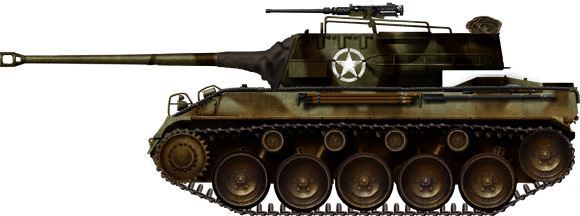
Camouflaged Hellcat at Anzio, May 1944, camouflage scheme deduced from a front picture. Notice the early gun without muzzle break.
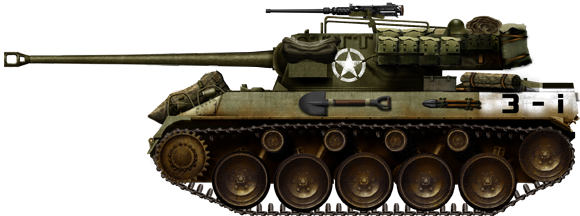
M18 Hellcat in Italy, 1944.
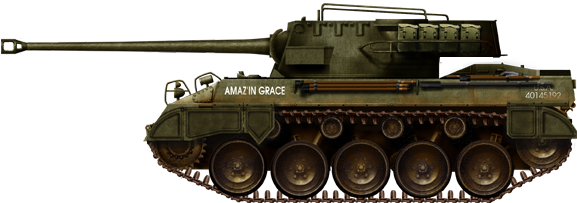
M18 “Amazin Grace” from an unknown US Army unit in France, 1944.
.
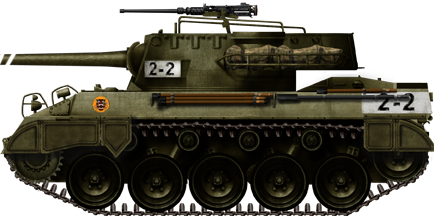
Hellcat from the 805th Tank Destroyer Battalion in Italy, 1944.
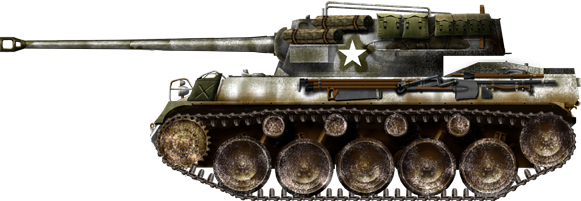
Battle of the Bulge, winter 1944-45.
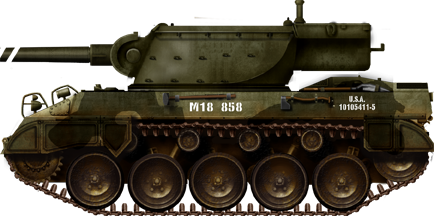
“Super Hellcat” in 1944, with an olive green/dark brown camouflage
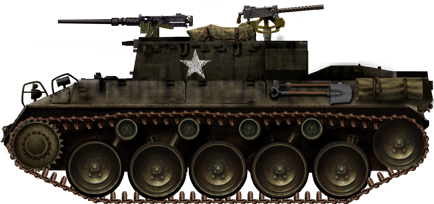
M39 Carrier in Korea, 1952.
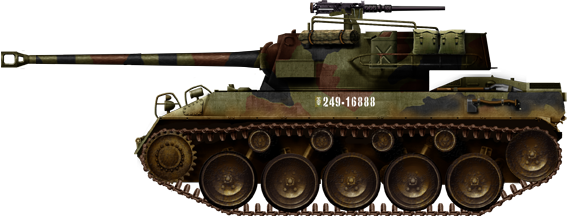
Hellcat from the 249 MAC Division, Republic of China, 1980s.
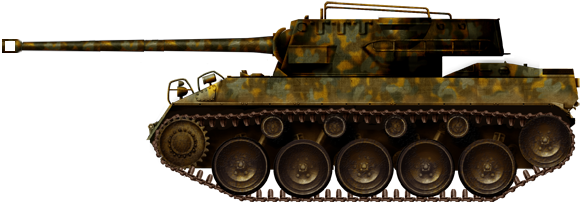
Bosnian Serb M18 Hellcat in 1995.
Gallery
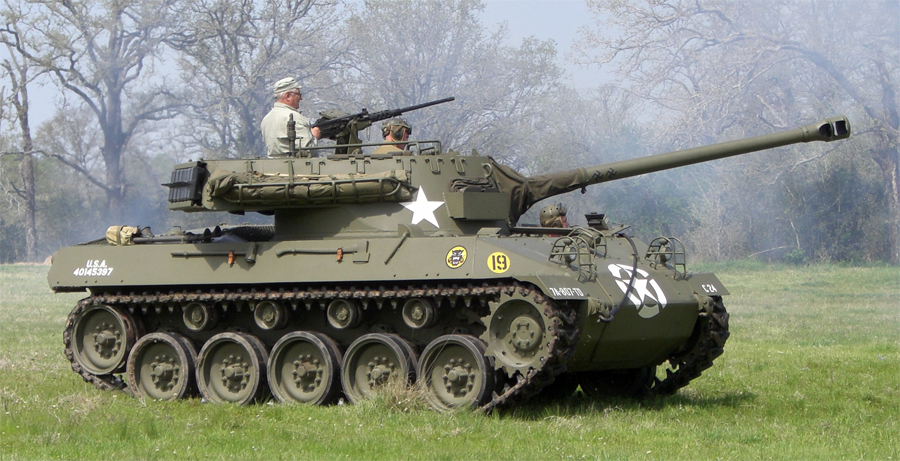
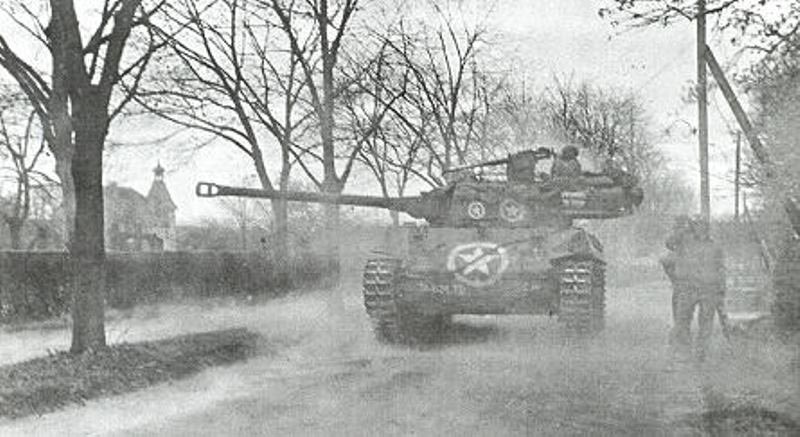
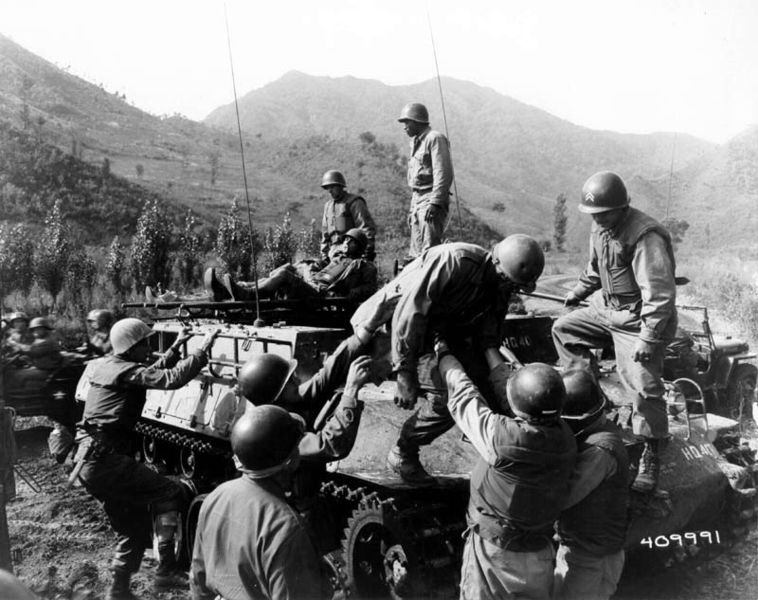
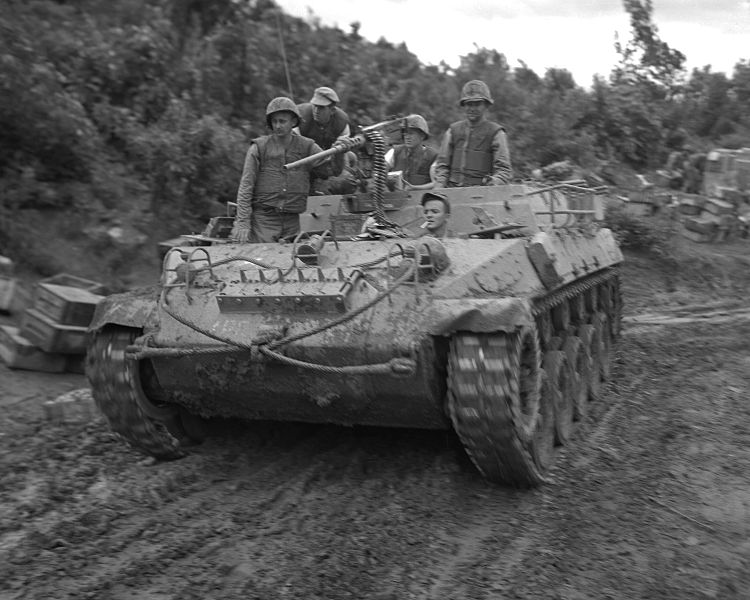

WW2 Tanks




























WW2 tanks posters

All Tiger tanks liveries.

Panther liveries and variants

WW2 Armour - All tanks











Tanks aces and single tanks series

Find more there

Museums, Movies, Books & Games
The Tanks and Armor in pop culture
Tanks and armored vehicles in general are only really grasped when seen first person: The mass, the scale, it's all there. Explore also the way tanks were covered in the movie industry, in books and in video games.Movies:
Best tanks movie on warhistoryonline.com
On imdb.com
On bestsimilar.com/
miltours.com
liveabout.com/
watchmojo.com
Video Games:
pcgamesn.com
historyhit.com
levvvel.com
vg247.com/best-tank-games
mmobomb.com/
alienwarearena.com

